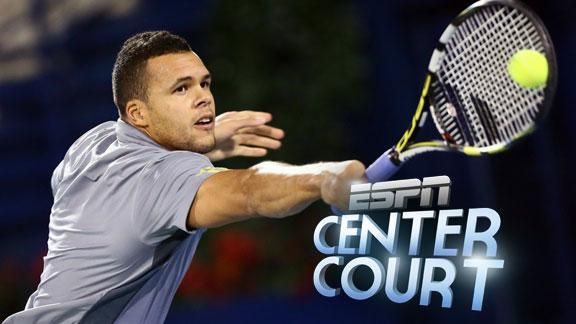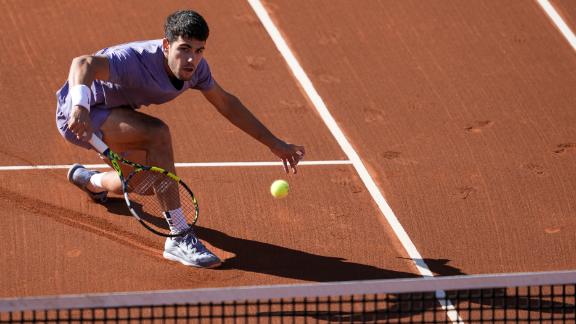Roger Federer and 30-year-old cohorts thriving
It started with the Baby Boomer generation. If you haven't already, I encourage you to buy stock in assisted living facilities, investment firms and prescription drug companies -- but only when the moment is right.
As usual, life is trickling down into sports. Tom Brady is under contract to play quarterback for the New England Patriots past his 40th birthday. Mark Martin, at the doddering age of 54, just finished third in the Daytona 500. Last year, some 13 of the 66 champions of the ATP World Tour events were 30 years or older.
"It was unexpected," Melzer said last week from Memphis. "I'm less flexible than I used to be at 25. If I don't watch what I do after a match, I really feel it the next day."
There are no teenagers in the ATP top 100, only two 20-year-olds (Bernard Tomic and Ryan Harrison) and one 21-year-old (Grigor Dimitrov). At the same time, there are -- no, wait …
Exactly how many 30-somethings are ranked among the ATP Tour top 100?
"I'll go with 15," said American Michael Russell, who at 34 is the third oldest in the top 100.
Actually, there are 27 men age 30 or older in that stellar century group.
"Wow," Russell said, "that's amazing. More than a quarter of the top 100? Way more than I thought."
Sometimes, Russell hears the old-guy jokes in the locker room.
"Usually they're coming from guys who are over 30 too," he said. "That's funny, because I don't feel like an old man."
Russell said this last week from Memphis, where he enjoyed a nice run into the quarterfinals. Earlier this week in Delray Beach, Fla., Russell was forced to retire from his match against Sam Querrey with a left leg injury.
Roger Federer, 31 and 6 months, is the 15th-oldest man in the top 100 -- and he's ranked No. 2. David Ferrer, who will turn 31 in April, is No. 4. Federer pushed Andy Murray to five sets in the semifinals of the Australian Open. Ferrer has won an ATP World Tour-high 17 matches this year and has won titles in Auckland and Buenos Aires.
Last year at Roland Garros, 37 of the 128 players in the draw were 30 years or older. That's 29 percent. Ten years ago? The total was 11. At Wimbledon, there were 16 30-something women in the draw, an Open era record. Serena Williams, born about two months after than Federer, won that tournament, then the Olympics and U.S. Open. At 31, she is the oldest woman ever to be ranked No. 1.
The WTA has 11 teenagers ranked among its top 100 players. The highest is American Sloane Stephens, who is No. 17. Two decades ago, there were four teenagers in the top 10: Monica Seles, Arantxa Sanchez-Vicario, Jennifer Capriati and Magdalena Maleeva.
The average age of the top 10 players, on both the men's and women's sides, has gone up more than three years in the past two decades.
Why? The technology is there to prolong careers -- and so are the financial incentives to stay out there.
Russell, who lives in Houston, is ranked No. 72 and enjoying a rare renaissance in the sport that traditionally eats its elders. In his first 73 ATP events, he never reached the quarterfinals. In his past 53, the 5-foot-8, 155-pounder has done it six times, including last week in Memphis.
"I'm like a good wine from the south of France," he said. "Seriously, I think it's the physicality of the game. You don't see as many guys like Boris Becker at Wimbledon any more, coming out at 6-foot-3, 180 pounds at the age of 17. Today, it's a lot of 6-5 guys, who move well from the ground and have big serves. In order to compete with them, guys have to be physically stronger, and that doesn't happen until the mid-20s."
Russell said he spends nearly as much time off the court as on, keeping his body in tune with post-play stretching, ice and massages. His wife, Lilly, a former fitness competitor, has traveled with him for the past three years and acts as his physiotherapist.
No, Russell did not see himself playing past the age of 35 -- which he will turn May 1.
"Definitely not," he said. "Looking back at the statistics, usually when you hit 30 your tennis career is pretty much over. I love to compete, so it's been fantastic. I'm definitely going to play to the end of this year, then re-access how my body is. I think I could go another year or two before calling it quits."
Melzer is of the same mind. Ranked No. 49, he is still a viable player. Consider his recent rankings history. In 2008 -- at the age of 27 -- he was ranked No. 34. And then this progression: No, 28, No. 11, No. 33, No. 29.
"I matured late as a tennis player," Melzer said. "Having a great 2010 season, still under 30, that boosted my confidence. Everything is different than it was 30 years ago. The science of recovery, having a team of people to support you … those things make it possible to compete at a later age."
Melzer is focused on 2013 and, perhaps, 2014.
"The furthest I would take it is Rio [the 2016 Olympics]," he said. "To be honest, I was always hoping to have a long career, but winning tournaments at age 30 wasn't one of the dreams. In the end, it turned out I am still able to do it."
Five Questions With Tommy Haas

When he was laid out in a Vail, Colo., recovery room after undergoing surgery on his right hip in February 2010, Tommy Haas was not thinking happy thoughts. Safe to say, a month later in New York, following another procedure on his right elbow, he was not in a positive frame of mind either.
Hass did not, for example, envision himself two years later besting Roger Federer -- on grass -- in the final at Halle before an adoring crowd in his home country of Germany to become the oldest ATP World Tour singles champion in four years. Nor did Haas imagine he would reach back-to-back finals, in Hamburg and Washington, D.C.
"I surprised myself in many ways," Haas said earlier this week from his home in Bradenton, Fla.
Haas is, impossibly, going to turn 35 years old on April 3. He is the second-oldest man ranked among the ATP's top 100 players -- kudos if you knew Spain's Ruben Ramirez Hidalgo, who turned 35 in January, is the oldest. But Haas is the only one in the top 20, this week at No. 19. Last year, he was the Comeback Player of the Year, leaping 184 spots into the top 25.
"I have a different outlook than five, 10 years ago," Haas said. "I'm not looking forward too far down the road. I'm thankful for every match I win, every chance I get to go out and compete. Some of these tournaments I'm playing, I think maybe it's for the last time. Maybe not."
Haas lost in the first round of the Australian Open to Jarkko Nieminen but rebounded to reach the final in San Jose. He beat John Isner to get there but fell to Milos Raonic. A week ago, Haas won his first-round match in Memphis but withdrew from a second-round match with Feliciano Lopez when he was overtaken by a bad cold.
He is the second seed this week in Delray Beach, where ESPN.com caught up with him after a practice.
ESPN.com: Twenty-seven guys 30 or over are in the top 100; it's like an epidemic. Why do you think so many older guys doing so well?
Tommy Haas: I think we're all a little more aware of taking care of our bodies better. Health makes a much bigger statement than it did 15, 20 years ago. Let's be honest, we rely more on our bodies than most other jobs. Athletes try to get as much as they can out of their bodies, so you try to keep it a well-oiled machine. The longer your lifespan in sport, the longer you can do the thing you love to do.
ESPN.com: How is your body different, specifically, at close to 35 than at 25?
Tommy Haas: Well, I'm a lot smarter, that's for sure. The more experiences you have, the wiser you are, right? In your mind, you know that physically as you get into your 30s you are hanging by a thread. Now I know that the best chance I have to move around the way I need to is having a lean body. When I was 25, I didn't have those kinds of thoughts. I guess I thought if I got to 30, maybe it would be time to look for something new in life. But injuries really changed my thinking.
ESPN.com: Is it possible that suffering those injuries might have helped make it possible for you to have this kind of advanced longevity?
Tommy Haas: Exactly. When you are away from the sport, you really appreciate what you were missing. You're not sitting on the sideline because you're mentally burned out. It's very frustrating to go through injuries and rehab and attempt a comeback. You ask yourself: What level can I come back to? Can I win another tournament? When I had the hip surgery, there were many unknowns. Would I be able to move well enough to win? You know, is it worth the hassle of working so hard? I missed two, three years total to injuries. Maybe that's why I can still wrap my head around the idea of playing a full schedule in 2013. Maybe if I played a full schedule every year, grinding it out like Andy Roddick did, I'd be retired.
ESPN.com: How do you compare now to the player you were 10 years ago?
Tommy Haas: I pulled out of Memphis with a cold, and I went home and rested for three days. When I went out to practice in Florida, I felt like I didn't have any energy. The humidity was bad, and I couldn't really breathe or even move. I was like, "Wow, one week and that's how far you fall off." On days like that you feel at least like 34, 35 -- or even older. On other days, I feel like I'm 21, 22. I can move all day.
ESPN.com: Professional tennis is a grind. How long will you be able to deal with the mundane downside of the sport?
Tommy Haas: That's the trick question that I always ask myself. The pro life sounds glamorous -- and there are times at the big events when it is really great -- but the hotel life gets old. I'll lie in my bed at 8 p.m. and think that I'd much rather wake up with my fiancée [Sara Foster] and daughter [Valentina]. Over the years, I've made a lot of friends, and it's nice when you can stay with people -- it's a lot more like being at home. As long as I'm enjoying myself, physically and mentally, and have some success here or there, I'll continue. For sure, the rest of the year and maybe a year after that. One of my goals is for my daughter to see me play and realize what her dad's doing. She'll turn 2 in the fall and get an opportunity to see some tournaments later this year. That means a lot to me. There will be a point when it is taken away from me, and then there will be a lot of other choices for me. Until that time, I'm just going to ride it as long as I can.
On The Move
Who's Hot

Victoria Azarenka: 14-0 (1.000)
Novak Djokovic: 8-0 (1.000)
Andy Murray: 10-1 (.909)
David Ferrer: 17-2 (.895)
Rafael Nadal: 7-1 (.875)
Serena Williams: 12-2 (.857)
Agnieszka Radwanska: 17-3 (.850)
Kei Nishikori: 11-2 (.846)
Richard Gasquet: 15-3 (.833)
Jo-Wilfried Tsonga: 9-2 (.818)
Juan Martin del Potro: 8-2 (.800)
Who's Not

Varvara Lepchenko: 3-5 (.375)
Su-Wei Hsieh: 4-6 (.400)
Juan Monaco: 2-3 (.400)
Fernando Verdasco: 2-3 (.400)
Samantha Stosur: 5-7 (.417)
John Isner: 3-4 (.429)
Dominika Cibulkova: 5-6 (.455)
Lucie Safarova: 5-6 (.455)
The return of J.J.

Last year, she finished outside the top 20 for the first time in seven years, losing in the opening round 14 times.
Last week, Jelena Jankovic returned to the winner's circle for the first time in nearly three years with a victory in the Copa Claro Colsanitas in Bogota, Colombia.
Sure, it was a minor event and, true, she beat only one player ranked among the top 100 (Alexandra Cadantu of Romania), but Jankovic will take the 280 rankings points, the $40,000 prize and a blast of confidence.
It was Jankovic's 13th WTA title and ended a 0-for-5 losing streak in finals. The former world No. 1, who turns 28 on Thursday, has struggled in recent years. She lost to fellow Serb Ana Ivanovic, another former No. 1, in the third round of the Australian Open but has fashioned an 8-3 record in 2013 and continues to travel without a coach.
While the cat's away …

With the big four all out of action last week, the underlings had a fiesta in their absence. No. 8-ranked Jo-Wilfried Tsonga defeated No. 6 Tomas Berdych 3-6, 7-6 (6), 6-4 at the Open 13 final in Marseille, France.
The Frenchman saved a match point in that second-set tiebreaker -- and five match points in the quarterfinals against Bernard Tomic. It was the 10th ATP World Tour title for Tsonga, who ended a 0-for-3 run against Berdych.
Meanwhile, No. 4-ranked David Ferrer was the titlist in Buenos Aires' Copa Claro, defeating Stanislas Wawrinka in the final. It was the 20th ATP title for Ferrer and the 10th on clay, tying him with Roger Federer and Nikolay Davydenko for the third-most clay titles among active players.
It won't be so easy this week, with No. 1 Novak Djokovic and No. 2 Federer in the Dubai field, along with Tsonga, Berdych and No. 7-ranked Juan Martin del Potro.
Nishikori rolls

Remember five years ago when a Japanese teenager named Kei Nishikori won the title at Delray Beach?
Well, he's back.
Now 23, Nishikori took the title in Memphis, beating Feliciano Lopez in a straight-sets final. He did not drop a set all week. Nishikori, always a stylish shot-maker, seems to have developed a more physical presence. His ranking moved up six spots to No. 16 -- one below last year's career high that was achieved after winning in Tokyo.
A product of the Nick Bollettieri Academy in Bradenton, Fla., Nishikori is 11-2 on the season, the eighth-best record among all professionals.
Bob and Mike Bryan won the Memphis doubles, their 85th team title, beating James Blake and Jack Sock in the final. Their first-ever crown came in Memphis a dozen years ago. Earlier this year, the Bryans won their record 13th major at the Australian Open. At the age of 34, they have won three of the four events they've entered this year.
Etcetera

Rafael Nadal and the world's most scrutinized left knee will make an appearance in New York City on Monday night.
Nadal will take on 2009 U.S. Open champion Juan Martin del Potro in the BNP Paribas Showdown at Madison Square Garden. It has been reported that Nadal, who is coming off a seven-month hiatus because of a knee injury, will be paid $1.5 million for the event.
In the other marquee matchup, No. 1 Serena Williams meets No. 2 Victoria Azarenka. After pulling out of tournaments in which they might have faced each other a collective three times, they are scheduled to meet for the first time since Williams took Azarenka's No. 1 ranking.
In addition, the International Tennis Hall of Fame Class of 2013 will be revealed as part of the World Tennis Day celebration. Nominees include: Martina Hingis (5 majors), Michael Stich (18 titles, including 1991 Wimbledon) and ESPN tennis analyst Cliff Drysdale (six-time ATP winner).
Tennis benefits … homework?
According to a study conducted by USTA Serves, the organization's national charitable foundation, tennis is a catalyst for educational advantage. The study conducted among high school students found that nearly half of the tennis players maintained an A average and 81 percent said they intend to attend college. Some 73 percent of tennis players said they had never been sent to the principal's office.
Both sides of the ball
This week, the Virginia men and North Carolina women are first in the ITA Division I college tennis rankings. Also worth noting are the 10 institutions with teams ranked among the top 25 for both men and women: California, Clemson, Duke, Georgia, Michigan, Northwestern, Texas A&M, UCLA, USC and Vanderbilt. Three teams -- Duke, Georgia and UCLA -- have both teams inside the top 10.
Lords of the Dance
Kenyon needed almost six hours, but the Lords eventually managed a 5-4 upset of top-seeded Emory on Sunday in the final of the ITA Division III National Men's Team Indoor Championship on the campus of Gustavus Adolphus College. No. 2 Kenyon fell behind 2-1 after doubles but managed to rally in singles play for its first national championship in program history.
Indian Wells wild cards
Recipients for the 2013 BNP Paribas Open: former top-five players David Nalbandian, Tommy Robredo, James Blake and Kimiko Date-Krumm; Americans Tim Smyczek, Steve Johnson, Madison Keys, Bethanie Mattek-Sands, Maria Sanchez, Melanie Oudin and Taylor Townsend; and Shahar Peer and Kristina Mladenovic were granted wild cards into the main draws. Qualifying wild cards were given to Americans Christian Harrison, Jack Sock, Rhyne Williams, Dennis Novikov, Grace Min, Jessica Pegula and Irina Falconi, German Andrea Petkovic and Croatian Ajla Tomljanovic.




